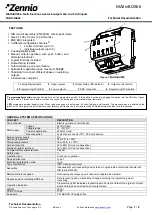
UG-1828
Preliminary Technical Data
Rev. PrC | Page 296 of 338
Correct shutdown should be performed by executing one of these options:
•
Selecting
“File”
->
“Shutdown Zynq Platform”
in the TES.
•
Pressing the SW9 push button on the ZYNQ platform
After a few seconds, when all 4 GPIO LEDs on the ZYNQ platform blink together, the user can safely power off the system using SW1 on
the ZYNQ platform.
ZYNC ZCU102
1.
Turn on the evaluation system by switching the ZCU102 evaluation platform power switch (SW1) to the on position. If hardware is
connected correctly, two green LEDs (D801 and DS901) on the ADRV9001 evaluation card should be on.
8.
The ZCU102 evaluation platform uses a Linux operating system. It takes approximately 30 seconds before the system is ready for
operation and can accept commands from PC software. Boot status can be observed on ZCU102 evaluation platform GPIO LEDs
(DS37 – DS40). The correct sequence should follow the description below:
a.
After SW1 is turned on, all 4 LEDs should start flashing (moving single OFF light).
b.
On the ADRV9001 Evaluation board the System OK LED should also begin to flash.
c.
These LEDs will continue to flash in the same sequence through FPGA boot up, TES connection and TES program.
d.
When boot is done ‘Init’ LED is green and ‘Init Done’ led is on in the Power and Status LEDs.
2.
The ADRV9001 reference clock signal (in range from 10 MHz to 1000MHz, CW tone, +13dBm max) should be connected to J501.
a.
It should be noted that quality of clock source used to generate DEV_CLK will directly impact overall system performance.
User must ensure that high quality, stable and low phase noise clock source is used here.
3.
For receiver testing on the ADRV9001 evaluation card, use a clean signal generator with low phase noise to provide an input signal to
the selected Rx RF input. Use a shielded RG-58, 50Ω coaxial cable (1m or shorter) to connect the signal generator.
4.
To set the input level near the Rx receiver’s full scale, the generator level (for a single tone signal) should be set to approximately -
15dBm. This level depends on the input frequency and the gain settings through the path.
a.
Note that there should be no input signal applied to the Rx input when performing an init calibration.
5.
For transmitter testing, connect a spectrum analyser to either Tx output on the ADRV9001 evaluation card. Use a shielded RG-58,
50Ω coaxial cable (1m or shorter) to connect the spectrum analyser.
a.
Both Tx outputs should be terminated, either into spectrum analysers or into 50Ω if unused. This is because the initial
calibrations will run on both channels and can take a long time to complete if a Tx channel is not correctly terminated.
6.
Power off must be executed using TES software before the user powers off the evaluation system by switching SW1 to off position.
Important
The ADRV9001 evaluation system uses a Linux operating system. Linux requires time to boot up as well as soft shut down before
hardware power off. The user is expected to use the software power off feature from the TES before physically switching power off using
SW1. If this advice is not followed, the file system on the SD card can get corrupted and the ADRV9001 evaluation system might stop
operating.
TRANSCEIVER EVALUATION SOFTWARE (TES)
Installation and Configuration
Customers should contact an ADI representative to obtain access to TES. After the initial software download, copy the software to the
target system and unzip the files (if not already unzipped). The downloaded zip container should have an executable file that installs the
SDK and then the evaluation software.
Administrator privileges are not demanded by TES installer by default. However, if user intends to install TES to a folder that requires
administrative privileges, then installation process must run with administrator privileges.
After running an executable file, a standard installation process follows. Figure 275 shows the recommended configuration. Microsoft
.NET Framework 4.5 or newer is necessary for TES to operate. During installation process TES will look for Microsoft .NET Framework
and if not available on PC it will try to download it from Microsoft server. When Microsoft .NET Framework installation is selected,
installer will check and inform the operator if newer version is already installed. If so, it will skip .NET Framework installation.
















































